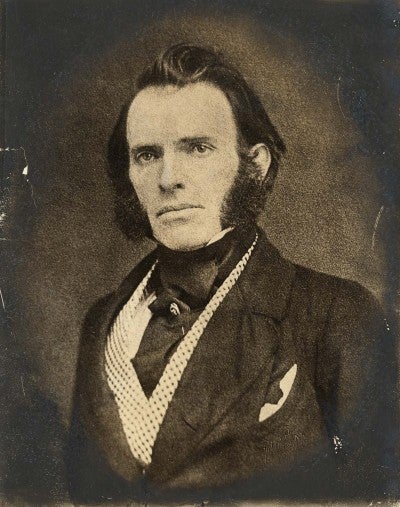
Academic Head
Benjamin Franklin Greene, A.M., C.E., was born in Lebanon, New Hampshire, October 25, 1817, the oldest of ten children. As a young man he made his way across upper New England to Brandon, Vermont, where he found employment in iron works. In 1841 he contacted Amos Eaton, applying for admission as a student at the Rensselaer Institute, although he was already 24 years old. Greene graduated in 1842, just when Eaton died. From 1843 to 1846 he was professor of mathematics and natural philosophy at Washington College in Maryland, and then became director of Rensselaer and professor of mechanics, machines and constructions from 1847 to 1859.
In 1847 Greene became the new senior professor at Rensselaer Institute and in 1850 became director. From 1847 to 1859 Greene struggled to elevate the Institute and transform it. In 1855 Greene conducted an extensive study of the technical schools of Europe, such as the École Polytechnique of Paris and the Polytechnisches Institut in Vienna. As a result, he wrote an extensive report entitled “The True Idea of a Polytechnic Institute,” summarizing the progress of technical education in Europe, and setting forth his own views. Greene envisioned changing the school from a one-year graduate program to a comprehensive undergraduate program, and promoted his ideas to the Rensselaer Board of Trustees.
Under Greene, enrollment increased from 20 to about 100 students. The faculty was enlarged and diversified in scope, and Greene engaged the first French and German-born professors to teach at Rensselaer.
Greene’s vision reached beyond the actuality of what could be accomplished. In 1856 he proposed the development of a new campus on a hill overlooking Troy. He envisioned the future Rensselaer in terms of an expanded technological university. Such a vision required money, to be obtained by the Board of Trustees, that was composed of Troy’s leading citizens. His program was too ambitious for the time and difficulties developed between Greene and the trustees. In 1859 Greene was forced to resign. Subsequently, he opened a rival institution in Troy, the Glenmore School for Engineers, but the venture did not prosper. Greene moved on to become chief clerk of the U.S. Navy Bureau of Navigation from 1863 to 1873. He then served as superintendent of Compasses in the U.S. Navy where he achieved recognition for his scientific research, particularly in the use of compasses on the new iron ships.
B.F. Greene died in West Lebanon, New Hampshire on November 22, 1895.
